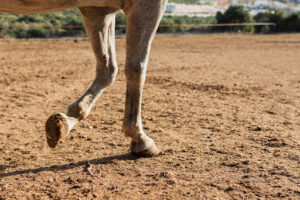How to Care for Horse Tack Year-Round
Next to your horse, tack is one of the most significant investments an equestrian can make. And just like your horse, it needs proper care and attention to do its job. Neglected tack doesn’t just look bad. It can stiffen, break, or become the victim of mold and rodents. Regardless of whether your saddle is […]

Next to your horse, tack is one of the most significant investments an equestrian can make.
And just like your horse, it needs proper care and attention to do its job.
Neglected tack doesn’t just look bad. It can stiffen, break, or become the victim of mold and rodents.
Regardless of whether your saddle is synthetic or leather, there are a few things you should do regularly to keep your investment in good shape.
Safety First
Cleaning your tack isn’t just about making it shiny and keeping leather supple, although it certainly does that.
Tack cleaning is also an opportunity to do a thorough inspection to check for potential safety problems, like cracked leather, frayed girth elastic or stretched buckle holes.
The single most important thing that you can do for your tack is to clean it regularly. Wipe it down after every ride, and clean and condition it weekly. At least every few months, take every part of your saddle and bridle apart and thoroughly clean, condition and inspect it.
Pay special attention to areas that are under stress, get a lot of wear and tear (like buckle holes), or where sweat tends to collect, like under girths and martingales.
Check D-rings, billet straps, stitching, buckle and bit attachments for cracking or wear. Make sure bit hooks on bridles are secure, and check “hidden” places, such as underneath where the browband attaches to the cheek pieces.
Swap your stirrup leathers every time you clean your saddle to prevent the left-side leather from becoming stretched with use, and ensure that your stirrup safety bars are down after cleaning the saddle.
Synthetic Tack Care
Synthetic tack has numerous advantages and has come a long way appearance-wise since it was first introduced to the equestrian world. Many synthetic saddles are virtually indistinguishable from leather saddles—especially black dressage saddles—and require significantly less care.
A quick wipe down with a barely damp sponge to remove sweat and dirt is enough to keep synthetic tack clean. A very mild detergent and warm water can be used to clean badly soiled synthetic tack, and a saddle cover is a good idea to prevent scuffs and keep saddles dust-free.
Synthetic tack still needs to be inspected for signs of damage, wear and tear, especially around buckle holes and any elastic components, such as on girths.
Synthetic accessories like halters, trail bridles, and boots can be cleaned with a stiff brush to remove dried mud, followed by warm water, mild detergent, and a thorough rinse to remove soap residue. Allow synthetic tack to dry naturally after it’s been cleaned.
How to Properly Store Tack
How you store your tack plays a huge role in how long your tack lasts, and what type of condition it’s in.
Temperature-controlled rooms are best for leather tack. In your home or a heated tack room is ideal, but any secure space that stays between 50-70 degrees F and has a regular 30-60% humidity level is ideal for tack.
Use a cotton or synthetic saddle cover to protect against dust and accidental damage, and avoid storing leather in plastic or anything that doesn’t allow air circulation. Tack that is not being used should still be conditioned occasionally to keep the leather soft and prevent cracking.

Rodents love leather, so make sure that anywhere you keep it is relatively rodent-proof, as these little monsters will chew through saddle pads, strap goods, the wool flocking from saddles, or whatever else they can get their hands on.
Saddles should be stored on a saddle rack or something similar (an old mailbox works great!) to support the saddle tree. Bridles should be stored on bridle racks which help keep the shape of the crownpiece (the piece that lays across the horse’s poll). Avoid hanging bridles on nails or skinny hooks.
If you have to put your saddle in the back of your car and can’t keep it on a saddle tree, rest it on it’s pommel (instead of the cantle) to reduce strain on the tree.
Leather Care
Leather cleaning involves two steps: cleaning and conditioning.
First, clean off any dirt using a tack sponge (or another soft sponge).
Moisten it and wring it out so it’s just damp enough to remove dust and dirt, but not so wet that it soaks the leather. Remove any surface dirt or ring dust, and wipe any sweat off bridles, martingales, or girths.
Warm water will dry out leather, so stick to cool (but not cold) water. In the case of extremely dirty, neglected leather, you may need to use warm water to clean off built-up grime. In this case, make sure to use glycerin soap or a rich conditioning soap immediately after to help rehydrate the leather.
Once the leather is clean, it’s time for conditioning. You have several options for leather conditioners, and chances are your saddle manufacturer has a product that they recommend or manufacture.
Generally speaking though, you have 2 options: traditional tack soap or liquid conditioners.
Using Saddle Soap
Using a damp sponge (a different one than you used to remove the dirt), rub a thin layer of glycerin-based tack soap into the leather. Pay attention to the nooks, crannies, and “out of the way” places, like under billet straps or between saddle flaps.
There are dozens of saddle soap options on the market, but Fiebing’s Saddle Soap is a perennial standby for quality and affordability. The kind that comes in a tin is also easier to use than a traditional Glycerine saddle soap bar, which can be messy if stored improperly. Keep the soap bar in a plastic container to prevent it from attracting dirt once it’s been used.
There are also several liquid saddle soaps, such as Oakwood Liquid Soap and Farnam Leather New, which is Glycerine-based. While a little more expensive than traditional solid soaps, they do a great job of keeping leather soft and supple and can be easier to use if you don’t like solid soap.

For leather that’s very dry, rub in several thin layers of soap and allow the leather to absorb it between applications, instead of applying one thick layer of soap.
After rubbing the saddle soap in, use a soft, dry cloth to remove the soap residue and give it a final sheen.
Using Conditioners
There are a ton of liquid leather conditioners on the market that make tack cleaning a breeze. Popular products are Stubben Hammanol, Lexol Leather Conditioner, Sterling Essentials Leather Conditioner, and Absorbine Leather Therapy.
Always follow the manufacturer’s instructions, but in most cases the conditioner can be applied with a tack sponge, cloth, or your fingers. Massage the conditioner into the leather, and then wipe down the saddle with a clean cloth to remove any residue.
Leather that is very dry will need special conditioning to regain its suppleness. After removing any dirt or grime, treat the leather with a product like Neatsfoot oil or another rich conditioner.
Avoid oiling saddles right before riding, as the oil may stain breeches.
How to Care for Bits

Clean your bit after every ride to remove saliva or food build-up. A quick dunk in your horse’s water bucket should do the trick, unless the bit is really dirty.
If you let your horse eat grass with a bit in his mouth (many trainers would advise against this), it’s vital to rinse leftover food off the bit. Dried, caked-on grass will become painful against the sensitive bars of the horse’s mouth.
If you use a rubber bit like a Happy Mouth or rubber bit, check the integrity of the rubber and replace it if you see signs the rubber is starting to break or decay.
Even bits that are cleaned regularly can become tarnished over time and need to be cleaned. Use a toothbrush and a product made for horse bits, such as Herm Sprenger Diamond Paste, to clean and polish it.
Detach the bit before cleaning, and rinse it thoroughly with clean water before reattaching it to the bridle.
Winter Tack Care
When temperatures drop, leather needs special attention to avoid becoming stiff and brittle.

The best thing you can do is to keep your tack in a temperature-controlled environment that’s between 50-70 degrees F during the day. If your tack room is unheated or very drafty, you might consider storing your saddle at home over the winter.
Humidity is especially important to leather during winter, as the use of space heaters and heating systems can dry out the indoor air. Avoid storing tack near heaters or vents to avoid drying out the leather.
Too much humidity, however, can advance mold and mildew growth, so try to maintain regular indoor humidity levels (30-60% relative humidity).
Be aware that oil or conditioner may take longer to absorb into cold leather, so take your tack inside for cleaning if you can.
Tack should receive its regular care routine all winter, as well as additional conditioning if it is stored in a cold barn and starts to become hard, or if it gets wet with snow or rain.
If your tack becomes soaked, for example if you’re caught in the rain or snow while riding, wipe it down with a dry sponge or clean towel as soon as you can. Then condition it, and let it dry naturally. Don’t place it near a heater to “help” it dry, as the harsh dry air can be punishing to wet tack.
In cold climates, warm the bit before popping it in your horse’s mouth, as metal bits can get extremely cold in the winter. Warm it in your hands, breathe on it, or use a bit warmer to keep it comfy for your horse.
Conclusion
<p style="box-sizing: inherit; overflow-wrap: break-word; margin: 0px 0px 1rem; padding: 0px; font-size: 20px; line-height: 1.6; text








